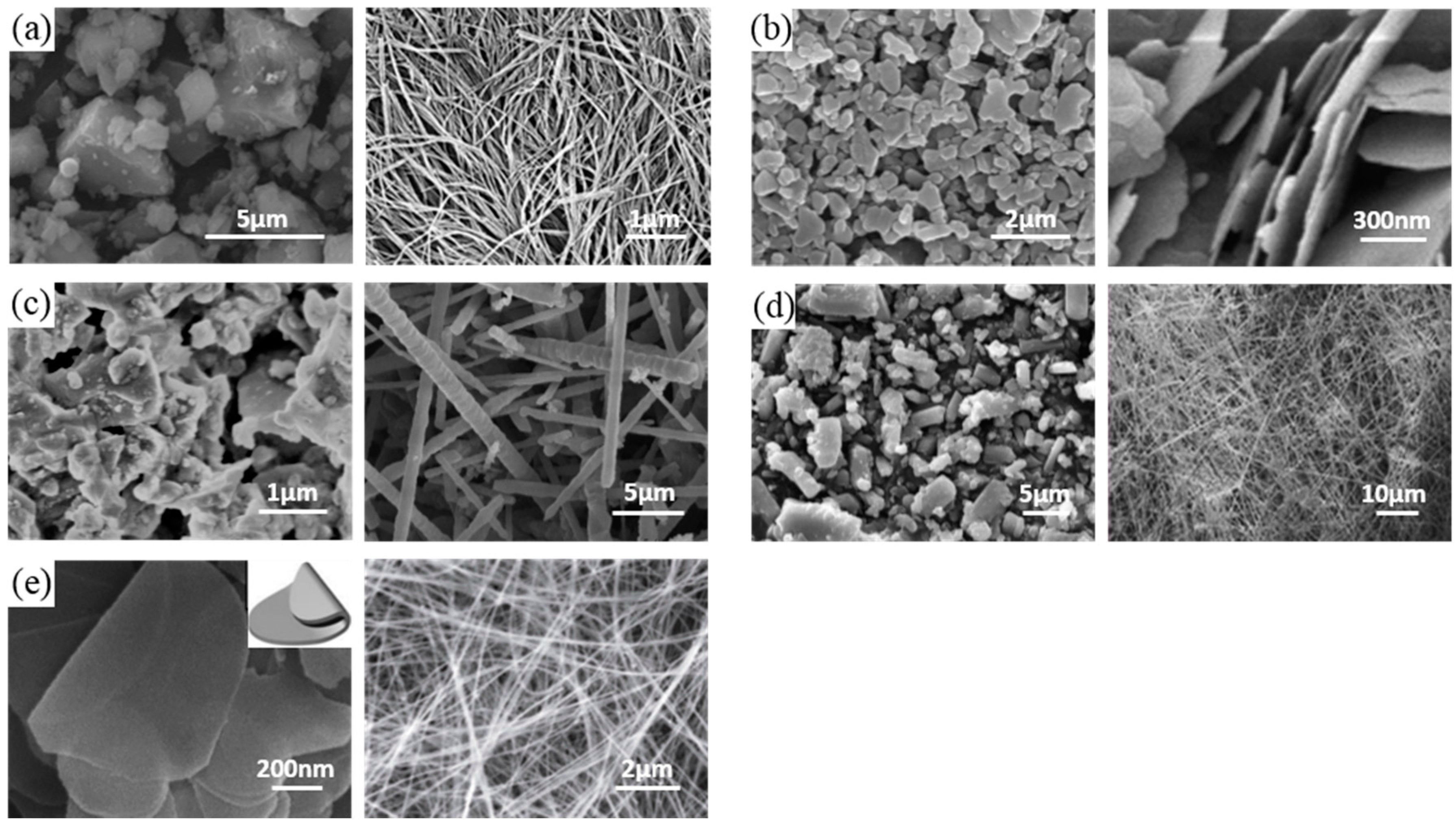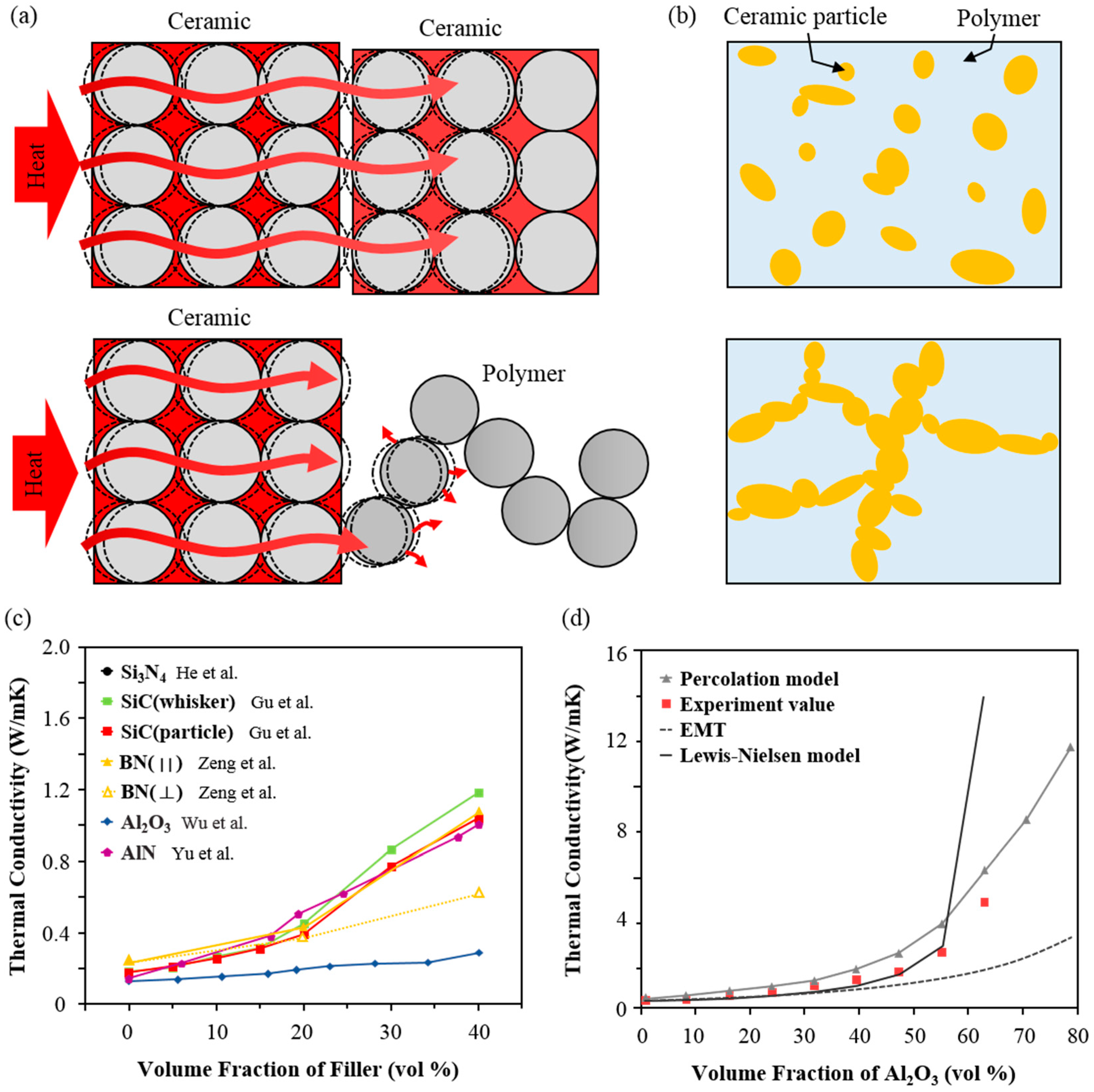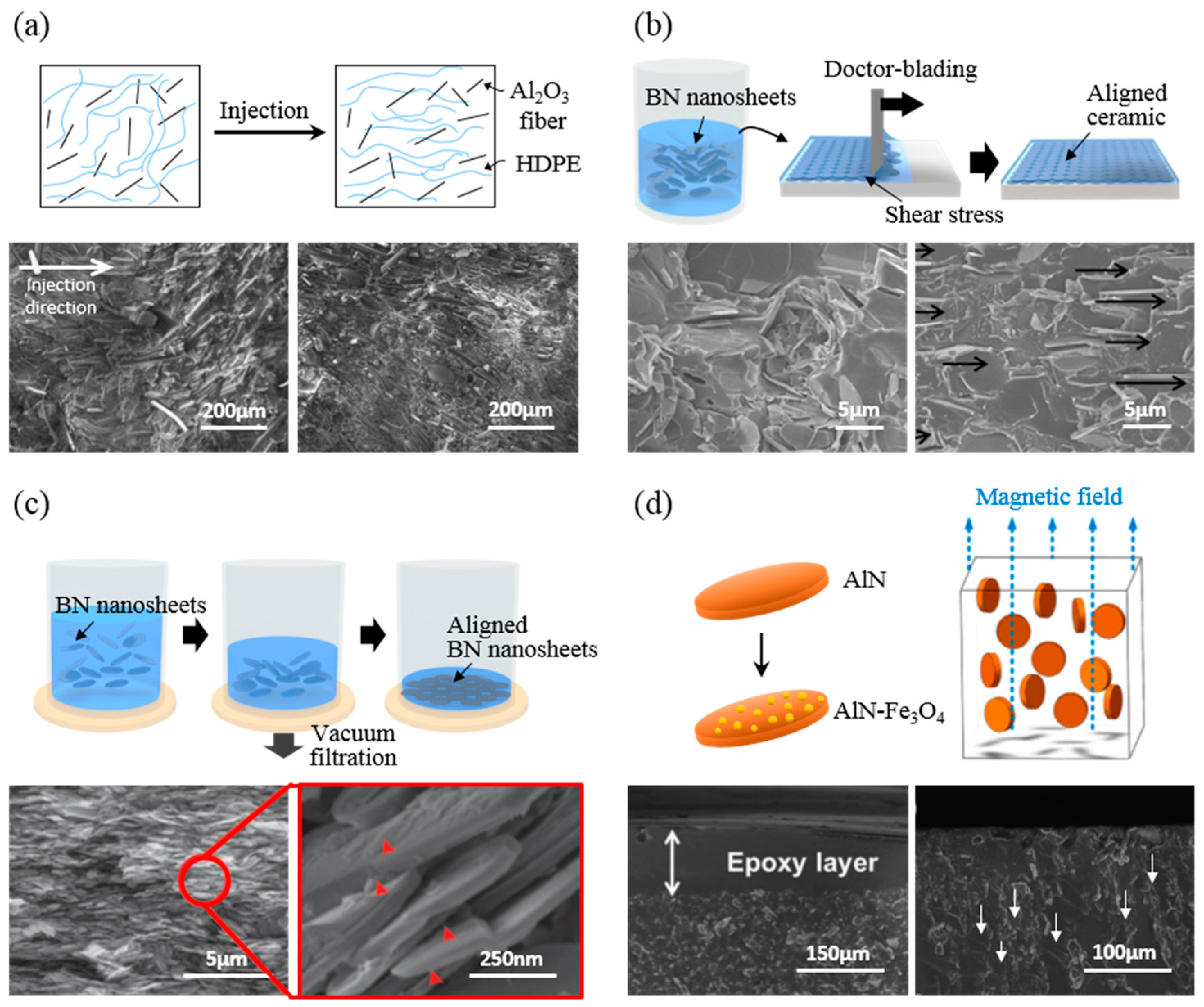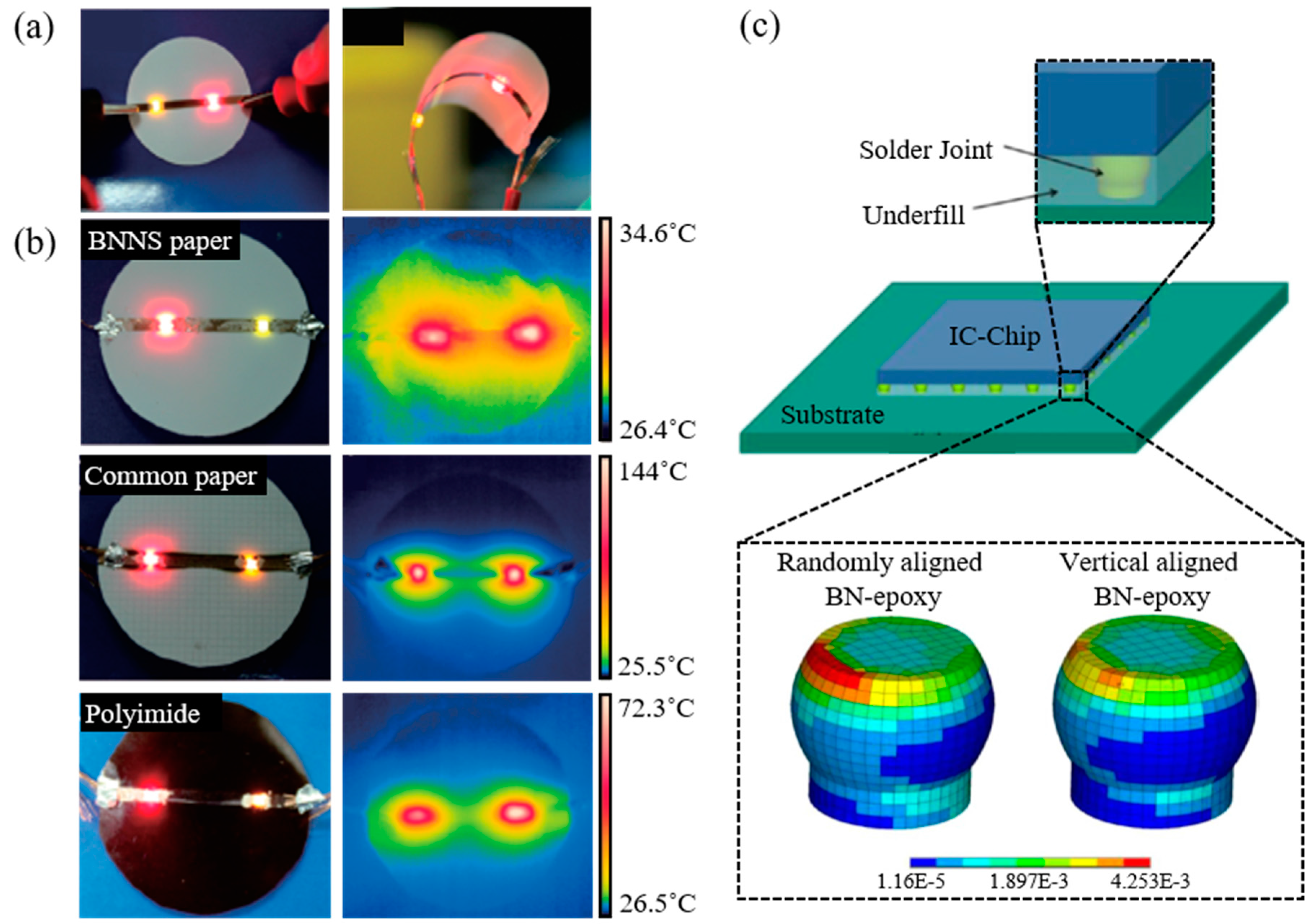Effective Assembly of Nano-Ceramic Materials for High and Anisotropic Thermal Conductivity in a Polymer Composite
Abstract
:1. Introduction
2. Materials for Thermal and Electrical Properties of Nanoscale Ceramics
3. Assembly of Nanoceramics for Composite
3.1. Randomly Dispersed Polymer-Ceramic Composites
3.2. Anisotropically Aligned Ceramic Fillers for a Composite
3.2.1. Injection Molding
3.2.2. Doctor Blading
3.2.3. Vacuum Assisted Assembly
3.2.4. Magnetic and Electric Field Alignment
3.3. Three-Dimensional (3D) Networked Assembly for Anisotropic Heat Conduction
3.3.1. Hot Pressing
3.3.2. Freeze-Casting
3.3.3. Self-Assembly
4. Application
5. Conclusions
Acknowledgments
Author Contributions
Conflicts of Interest
References
- Zhi, C.; Bando, Y.; Terao, T.; Tang, C.; Kuwahara, H.; Golberg, D. Towards thermoconductive, electrically insulating polymeric composites with boron nitride nanotubes as fillers. Adv. Funct. Mater. 2009, 19, 1857–1862. [Google Scholar] [CrossRef]
- Cui, Y.; Li, Y.; Xing, Y.; Ji, Q.; Song, J. Thermal design of rectangular microscale inorganic light-emitting diodes. Appl. Therm. Eng. 2017, 122, 653–660. [Google Scholar] [CrossRef]
- He, H.; Fu, R.; Shen, Y.; Han, Y.; Song, X. Preparation and properties of Si3N4/PS composites used for electronic packaging. Compos. Sci. Technol. 2007, 67, 2493–2499. [Google Scholar] [CrossRef]
- Chen, J.; Huang, X.; Zhu, Y.; Jiang, P. Cellulose nanofiber supported 3D interconnected BN nanosheets for epoxy nanocomposites with ultrahigh thermal management capability. Adv. Funct. Mater. 2017, 27, 1–9. [Google Scholar] [CrossRef]
- Burger, N.; Laachachi, A.; Ferriol, M.; Lutz, M.; Toniazzo, V.; Ruch, D. Review of thermal conductivity in composites: Mechanisms, parameters and theory. Prog. Polym. Sci. 2016, 61, 1–28. [Google Scholar] [CrossRef]
- Yu, H.; Heider, D.; Advani, S. Role of in-plane stacking sequence on transverse effective thermal conductivity of unidirectional composite laminates. Int. J. Heat Mass Transf. 2015, 85, 897–903. [Google Scholar] [CrossRef]
- Yang, K.; Gu, M. Enhanced thermal conductivity of epoxy nanocomposites filled with hybrid filler system of triethylenetetramine-functionalized multi-walled carbon nanotube/silane-modified nano-sized silicon carbide. Compos. Part A Appl. Sci. Manuf. 2010, 41, 215–221. [Google Scholar] [CrossRef]
- Hu, M.; Feng, J.; Ng, K.M. Thermally conductive PP/AlN composites with a 3-D segregated structure. Compos. Sci. Technol. 2015, 110, 26–34. [Google Scholar] [CrossRef]
- Yuan, Z.H.; Sun, S.Q.; Duan, Y.Q.; Wang, D.J. Fabrication of densely packed AlN nanowires by a chemical conversion of Al2O3 nanowires based on porous anodic alumina film. Nanoscale Res. Lett. 2009, 4, 1126–1129. [Google Scholar] [CrossRef] [PubMed]
- Sobhani, M.; Ebadzadeh, T.; Rahimipour, M.R. Formation and densification behavior of reaction sintered alumina-20 wt % aluminium titanate nano-composites. Int. J. Refract. Met. Hard Mater. 2014, 47, 49–53. [Google Scholar] [CrossRef]
- Suchanek, W.L.; Garcés, J.M. Hydrothermal synthesis of novel alpha alumina nano-materials with controlled morphologies and high thermal stabilities. CrystEngComm 2010, 12, 2996–3002. [Google Scholar] [CrossRef]
- Zhou, T.; Wang, X.; Mingyuan, G.U.; Liu, X. Study of the thermal conduction mechanism of nano-SiC/DGEBA/EMI-2,4 composites. Polymer 2008, 49, 4666–4672. [Google Scholar] [CrossRef]
- Li, S.; Zhang, Y.; Han, J.; Zhou, Y. Fabrication and characterization of SiC whisker reinforced reaction bonded SiC composite. Ceram. Int. 2013, 39, 449–455. [Google Scholar] [CrossRef]
- Kusunose, T.; Yagi, T.; Firoz, S.H.; Sekino, T. Fabrication of epoxy/silicon nitride nanowire composites and evaluation of their thermal conductivity. J. Mater. Chem. A 2013, 1, 3440–3445. [Google Scholar] [CrossRef]
- Huang, X.; Zhi, C.; Jiang, P.; Golberg, D.; Bando, Y.; Tanaka, T. Polyhedral oligosilsesquioxane-modified boron nitride nanotube based epoxy nanocomposites: An ideal dielectric material with high thermal conductivity. Adv. Funct. Mater. 2013, 23, 1824–1831. [Google Scholar] [CrossRef]
- Mamunya, Y.P.; Davydenko, V.V.; Pissis, P.; Lebedev, E.V. Electrical and thermal conductivity of polymers filled with metal powders. Eur. Polym. J. 2002, 38, 1887–1897. [Google Scholar] [CrossRef]
- Yu, A.; Ramesh, P.; Itkis, M.E.; Bekyarova, E.; Haddon, R.C. Graphite nanoplatelet—Epoxy composite thermal interface materials. J. Phys. Chem. C 2007, 111, 7565–7569. [Google Scholar] [CrossRef]
- Feng, W.; Qin, M.; Feng, Y. Toward highly thermally conductive all-carbon composites: Structure control. Carbon N. Y. 2016, 109, 575–597. [Google Scholar] [CrossRef]
- Wong, C.P.; Bollampally, R.S. Thermal conductivity, elastic modulus, and coefficient of thermal expansion of polymer composites filled with ceramic particles for electronic packaging. J. Appl. Polym. Sci. 1999, 74, 3396–3403. [Google Scholar] [CrossRef]
- Kim, J.; Kwon, J.; Lee, D.; Kim, M.; Han, H. Heat dissipation properties of polyimide nanocomposite films. Korean J. Chem. Eng. 2016, 33, 3245–3250. [Google Scholar] [CrossRef]
- Gojny, F.H.; Wichmann, M.H.G.; Fiedler, B.; Kinloch, I.A.; Bauhofer, W.; Windle, A.H.; Schulte, K. Evaluation and identification of electrical and thermal conduction mechanisms in carbon nanotube/epoxy composites. Polymer 2006, 47, 2036–2045. [Google Scholar] [CrossRef]
- Yu, S.; Hing, P.; Hu, X. Thermal conductivity of polystyrene—Aluminum nitride composite. Compos. Part A Appl. Sci. Manuf. 2002, 33, 289–292. [Google Scholar] [CrossRef]
- Guo, C.; Zhou, L.; Lv, J. Effects of expandable graphite and modified ammonium polyphosphate on the flame-retardant and mechanical properties of wood flour-polypropylene composites. Polym. Polym. Compos. 2013, 21, 449–456. [Google Scholar]
- Hu, Y.; Du, G.; Chen, N. A novel approach for Al2O3/epoxy composites with high strength and thermal conductivity. Compos. Sci. Technol. 2016, 124, 36–43. [Google Scholar] [CrossRef]
- Zhou, W.; Qi, S.; An, Q.; Zhao, H.; Liu, N. Thermal conductivity of boron nitride reinforced polyethylene composites. Mater. Res. Bull. 2007, 42, 1863–1873. [Google Scholar] [CrossRef]
- Liu, Z.; Wu, B.; Gu, M. Effect of hydrolysis of AlN particulates on corrosion behavior of Al/AlNp composite in neutral chloride solution. Compos. Part A Appl. Sci. Manuf. 2007, 38, 94–99. [Google Scholar] [CrossRef]
- Kozako, M.; Okazaki, Y.; Hikita, M.; Tanaka, T. Preparation and evaluation of epoxy composite insulating materials toward high thermal conductivity. In Proceedings of the 2010 10th IEEE International Conference on Solid Dielectrics (ICSD), Potsdam, Germany, 4–9 July 2010; pp. 1–4. [Google Scholar]
- Li, L.; Chung, D.D.L. Thermally conducting polymer-matrix composites containing both AIN particles and SiC whiskers. J. Electron. Mater. 1994, 23, 557–564. [Google Scholar] [CrossRef]
- Riley, F.I. Siliconnitride and related materials. J. Am. Ceram. Soc. 2000, 83, 245–265. [Google Scholar] [CrossRef]
- Hirao, K.; Wateri, K.; Hayashi, H.; Kitayama, M. High thermal conductivity silicon nitride ceramic. MRS Bull. 2001, 26, 451–455. [Google Scholar] [CrossRef]
- Duclaux, L.; Nysten, B.; Issi, J.-P.; Moore, A.W. Structure and low-temperature thermal conductivity of pyrolytic boron nitride. Phys. Rev. B 1992, 46, 3362. [Google Scholar] [CrossRef]
- Fujihara, T.; Cho, H.B.; Kanno, M.; Nakayama, T.; Suzuki, T.; Jiang, W.; Suematsu, H.; Niihara, K. Three-dimensional structural control and analysis of hexagonal boron nitride nanosheets assembly in nanocomposite films induced by electric field concentration. Jpn. J. Appl. Phys. 2014, 53, 02BD12. [Google Scholar] [CrossRef]
- Barkoula, N.M.; Alcock, B.; Cabrera, N.O.; Peijs, T. Fatigue properties of highly oriented polypropylene tapes and all-polypropylene composites. Polym. Polym. Compos. 2008, 16, 101–113. [Google Scholar]
- Hsieh, C.Y.; Chung, S.L. High thermal conductivity epoxy molding compound filled with a combustion synthesized AIN powder. J. Appl. Polym. Sci. 2006, 102, 4734–4740. [Google Scholar] [CrossRef]
- Wu, X.; Jiang, P.; Zhou, Y.; Yu, J.; Zhang, F.; Dong, L.; Yin, Y. Influence of alumina content and thermal treatment on the thermal conductivity of UPE/Al2O3 composite. J. Appl. Polym. Sci. 2014, 131, 1–11. [Google Scholar] [CrossRef]
- Huang, X.; Jiang, P.; Tanaka, T. A review of dielectric polymer composites with high thermal conductivity. IEEE Electr. Insul. Mag. 2011, 27, 8–16. [Google Scholar] [CrossRef]
- Zhou, T.; Wang, X.; Gu, M.; Xiong, D. Study on mechanical, thermal and electrical characterizations of nano-SiC/epoxy composites. Polym. J. 2009, 41, 51–57. [Google Scholar] [CrossRef]
- Watari, K.; Hirao, K.; Toriyama, M. Effect of grain size on the thermal conductivity of Si3N4. J. Am. Ceram. Soc. 1999, 82, 777–779. [Google Scholar] [CrossRef]
- Zhou, W.; Wang, C.; Ai, T.; Wu, K.; Zhao, F.; Gu, H. A novel fiber-reinforced polyethylene composite with added silicon nitride particles for enhanced thermal conductivity. Compos. Part A Appl. Sci. Manuf. 2009, 40, 830–836. [Google Scholar] [CrossRef]
- Li, X.; Chen, Y.; Kumar, A.; Mahmoud, A.; Nychka, J.A.; Chung, H.J. Sponge-templated macroporous graphene network for piezoelectric ZnO nanogenerator. ACS Appl. Mater. Interfaces 2015, 7, 20753–20760. [Google Scholar] [CrossRef] [PubMed]
- Borah, J.S.; Kim, D.S. Recent development in thermoplastic/wood composites and nanocomposites: A review. Korean J. Chem. Eng. 2016, 33, 3035–3049. [Google Scholar] [CrossRef]
- Park, Y.K.; Cho, C.H. Effects of additives on the mechanical and thermal properties of epoxy-based nanocomposites produced using sonication. Korean J. Chem. Eng. 2016, 33, 1938–1941. [Google Scholar] [CrossRef]
- Chen, P.H.; Chung, D.D.L. Thermal and electrical conduction in the compaction direction of exfoliated graphite and their relation to the structure. Carbon N. Y. 2014, 77, 538–550. [Google Scholar] [CrossRef]
- Pietrak, K.; Winiewski, T.S. A review of models for effective thermal conductivity of composite materials. J. Power Technol. 2015, 95, 14–24. [Google Scholar]
- Zeng, X.; Yao, Y.; Gong, Z.; Wang, F.; Sun, R.; Xu, J.; Wong, C.P. Ice-templated assembly strategy to construct 3D boron nitride nanosheet networks in polymer composites for thermal conductivity improvement. Small 2015, 11, 6205–6213. [Google Scholar] [CrossRef] [PubMed]
- Zhou, T.; Wang, X.; Liu, X.; Xiong, D. Improved thermal conductivity of epoxy composites using a hybrid multi-walled carbon nanotube/micro-SiC filler. Carbon N. Y. 2010, 48, 1171–1176. [Google Scholar] [CrossRef]
- Chen, H.; Ginzburg, V.V.; Yang, J.; Yang, Y.; Liu, W.; Huang, Y.; Du, L.; Chen, B. Thermal conductivity of polymer-based composites: Fundamentals and applications. Prog. Polym. Sci. 2015, 59, 41–85. [Google Scholar] [CrossRef]
- Enomoto, K.; Fujiwara, S.; Yasuhara, T.; Murakami, H.; Teraki, J.; Ohtake, N. Effect of filler orientation on thermal conductivity of polypropylene matrix carbon nanofiber composites. Jpn. J. Appl. Phys. 2005, 44, 24–27. [Google Scholar] [CrossRef]
- Prasher, R. Thermal interface materials: Historical perspective, status, and future directions. Proc. IEEE 2006, 94, 1571–1586. [Google Scholar] [CrossRef]
- Gu, J.-W.; Zhang, Q.; Zhang, J.; Wang, W. Studies on the preparation of polystyrene thermal conductivity composites. Polym. Plast. Technol. Eng. 2010, 49, 1385–1389. [Google Scholar] [CrossRef]
- Devpura, A.; Phelan, P.E.; Prasher, R.S. Percolation theory applied to the analysis of thermal interface materials in flip-chip technology. In Proceedings of the Seventh Intersociety Conference on Thermal and Thermomechanical Phenomena in Electronic Systems (ITHERM 2000), Las Vegas, NV, USA, 23–26 May 2000; pp. 21–28. [Google Scholar]
- Lin, Z.; Liu, Y.; Raghavan, S.; Moon, K.S.; Sitaraman, S.K.; Wong, C.P. Magnetic alignment of hexagonal boron nitride platelets in polymer matrix: Toward high performance anisotropic polymer composites for electronic encapsulation. ACS Appl. Mater. Interfaces 2013, 5, 7633–7640. [Google Scholar] [CrossRef] [PubMed]
- Kim, K.; Kim, J. Magnetic aligned AlN/epoxy composite for thermal conductivity enhancement at low filler content. Compos. Part B Eng. 2016, 93, 67–74. [Google Scholar] [CrossRef]
- Warzoha, R.J.; Fleischer, A.S. Heat flow at nanoparticle interfaces. Nano Energy 2014, 6, 137–158. [Google Scholar] [CrossRef]
- Terao, T.; Zhi, C.; Bando, Y.; Mitome, M.; Tang, C.; Golberg, D. Alignment of boron nitride nanotubes in polymeric composite films for thermal conductivity improvement. J. Phys. Chem. C 2010, 114, 4340–4344. [Google Scholar] [CrossRef]
- Shen, H.; Guo, J.; Wang, H.; Zhao, N.; Xu, J. Bioinspired modification of h-BN for high thermal conductive composite films with aligned structure. ACS Appl. Mater. Interfaces 2015, 7, 5701–5708. [Google Scholar] [CrossRef] [PubMed]
- Zeng, X.; Ye, L.; Yu, S.; Li, H.; Sun, R.; Xu, J.; Wong, C.P. Artificial nacre-like papers based on noncovalent functionalized boron nitride nanosheets with excellent mechanical and thermally conductive properties. Nanoscale 2015, 7, 6774–6781. [Google Scholar] [CrossRef] [PubMed]
- Yuan, C.; Duan, B.; Li, L.; Xie, B.; Huang, M.; Luo, X. Thermal conductivity of polymer-based composites with magnetic aligned hexagonal boron nitride platelets. ACS Appl. Mater. Interfaces 2015, 7, 13000–13006. [Google Scholar] [CrossRef] [PubMed]
- Kim, S.K.; Koo, H.J.; Liu, J.; Braun, P.V. Flexible and wearable fiber microsupercapacitors based on carbon nanotube-agarose gel composite electrodes. ACS Appl. Mater. Interfaces 2017, 9, 19925–19933. [Google Scholar] [CrossRef] [PubMed]
- Versavaud, S.; Régnier, G.; Gouadec, G.; Vincent, M. Influence of injection molding on the electrical properties of polyamide 12 filled with multi-walled carbon nanotubes. Polymer 2014, 55, 6811–6818. [Google Scholar] [CrossRef] [Green Version]
- Mirkhalaf, M.; Barthelat, F. Nacre-like materials using a simple doctor blading technique: Fabrication, testing and modeling. J. Mech. Behav. Biomed. Mater. 2016, 56, 23–33. [Google Scholar] [CrossRef] [PubMed]
- Xie, B.H.; Huang, X.; Zhang, G.J. High thermal conductive polyvinyl alcohol composites with hexagonal boron nitride microplatelets as fillers. Compos. Sci. Technol. 2013, 85, 98–103. [Google Scholar] [CrossRef]
- Ahn, H.J.; Eoh, Y.J.; Park, S.D.; Kim, E.S. Thermal conductivity of polymer composites with oriented boron nitride. Thermochim. Acta 2014, 590, 138–144. [Google Scholar] [CrossRef]
- Lu, J.; Weng, W.; Chen, X.; Wu, D.; Wu, C.; Chen, G. Piezoresistive materials from directed shear-induced assembly of graphite nanosheets in polyethylene. Adv. Funct. Mater. 2005, 15, 1358–1363. [Google Scholar] [CrossRef]
- Li, Q.; Guo, Y.; Li, W.; Qiu, S.; Zhu, C.; Wei, X.; Chen, M.; Liu, C.; Liao, S.; Gong, Y.; et al. Ultrahigh thermal conductivity of assembled aligned multilayer graphene/epoxy composite. Chem. Mater. 2014, 26, 4459–4465. [Google Scholar] [CrossRef]
- Liu, Z.; Guo, Q.; Shi, J.; Zhai, G.; Liu, L. Graphite blocks with high thermal conductivity derived from natural graphite flake. Carbon N. Y. 2008, 46, 414–421. [Google Scholar] [CrossRef]
- Erb, R.M.; Libanori, R.; Rothfuchs, N.; Studart, A.R. Composites reinforced in three dimensions by using low manetic fileds. Science 2012, 335, 199–204. [Google Scholar] [CrossRef] [PubMed]
- Kim, K.; Ju, H.; Kim, J. Vertical particle alignment of boron nitride and silicon carbide binary filler system for thermal conductivity enhancement. Compos. Sci. Technol. 2016, 123, 99–105. [Google Scholar] [CrossRef]
- Kim, K.; Kim, J. Vertical filler alignment of boron nitride/epoxy composite for thermal conductivity enhancement via external magnetic field. Int. J. Therm. Sci. 2016, 100, 29–36. [Google Scholar] [CrossRef]
- Kim, K.; Kim, M.; Kim, J.; Kim, J. Magnetic filler alignment of paramagnetic Fe3O4coated SiC/epoxy composite for thermal conductivity improvement. Ceram. Int. 2015, 41, 12280–12287. [Google Scholar] [CrossRef]
- Cho, H.B.; Nakayama, T.; Suematsu, H.; Suzuki, T.; Jiang, W.; Niihara, K.; Song, E.; Eom, N.S.A.; Kim, S.; Choa, Y.H. Insulating polymer nanocomposites with high-thermal-conduction routes via linear densely packed boron nitride nanosheets. Compos. Sci. Technol. 2016, 129, 205–213. [Google Scholar] [CrossRef]
- Fujihara, T.; Cho, H.B.; Nakayama, T.; Suzuki, T.; Jiang, W.; Suematsu, H.; Kim, H.D.; Niihara, K. Field-induced orientation of hexagonal boron nitride nanosheets using microscopic mold for thermal interface materials. J. Am. Ceram. Soc. 2012, 95, 369–373. [Google Scholar] [CrossRef]
- Cho, H.B.; Nakayama, T.; Suzuki, T.; Tanaka, S.; Jiang, W.; Suematsu, H.; Niihara, K. Linear assembles of BN nanosheets, fabricated in polymer/BN nanosheet composite film. J. Nanomater. 2011, 2011, 1–7. [Google Scholar] [CrossRef]
- Kamat, P.V.; Thomas, K.G.; Barazzouk, S.; Girishkumar, G.; Vinodgopal, K.; Meisel, D. Self-assembled linear bundles of single wall carbon nanotubes and their alignment and deposition as a film in a dc field. J. Am. Chem. Soc. 2004, 126, 10757–10762. [Google Scholar] [CrossRef] [PubMed]
- Fu, S.Y.; Feng, X.Q.; Lauke, B.; Mai, Y.W. Effects of particle size, particle/matrix interface adhesion and particle loading on mechanical properties of particulate-polymer composites. Compos. Part B Eng. 2008, 39, 933–961. [Google Scholar] [CrossRef]
- Yoon, B.H.; Choi, W.Y.; Kim, H.E.; Kim, J.H.; Koh, Y.H. Aligned porous alumina ceramics with high compressive strengths for bone tissue engineering. Scr. Mater. 2008, 58, 537–540. [Google Scholar] [CrossRef]
- Ferraro, C.; Garcia-Tunon, E.; Rocha, V.G.; Barg, S.; Farinas, M.D.; Alvarez-Arenas, T.E.G.; Sernicola, G.; Giuliani, F.; Saiz, E. Light and strong SiC networks. Adv. Funct. Mater. 2016, 26, 1636–1645. [Google Scholar] [CrossRef]
- Liu, Z.; Xu, J.; Chen, D.; Shen, G. Flexible electronics based on inorganic nanowires. Chem. Soc. Rev. 2015, 44, 161–192. [Google Scholar] [CrossRef] [PubMed]
- Kim, T.I.; McCall, J.G.; Jung, Y.H.; Huang, X.; Siuda, E.R.; Li, Y.; Song, J.; Song, Y.M.; Pao, H.A.; Kim, R.H.; et al. Injectable, celluar-scale optoelectronics with applications for wireless optogenetics. Science 2013, 340, 211–216. [Google Scholar] [CrossRef] [PubMed]
- McCall, J.G.; Kim, T.; Shin, G.; Huang, X.; Jung, Y.H.; Al-Hasani, R.; Omenetto, F.G.; Bruchas, M.R.; Rogers, J.A. Fabrication and application of flexible, multimodal light-emitting devices for wireless optogenetics. Nat. Protoc. 2013, 8, 2413–2428. [Google Scholar] [CrossRef] [PubMed]
- Kim, T.I.; Jung, Y.H.; Song, J.; Kim, D.; Li, Y.; Kim, H.S.; Song, I.S.; Wierer, J.J.; Pao, H.A.; Huang, Y.; et al. High-efficiency, microscale GaN light-emitting diodes and their thermal properties on unusual substrates. Small 2012, 8, 1643–1649. [Google Scholar] [CrossRef] [PubMed]
- Choi, M.K.; Park, I.; Kim, D.C.; Joh, E.; Park, O.K.; Kim, J.; Kim, M.; Choi, C.; Yang, J.; Cho, K.W.; et al. Thermally controlled, patterned graphene transfer printing for transparent and wearable electronic/optoelectronic system. Adv. Funct. Mater. 2015, 25, 7109–7118. [Google Scholar] [CrossRef]
- Lin, Z.; Yao, Y.; McNamara, A.; Moon, K.S.; Wong, C.P. Single/few-layer boron nitride-based nanocomposites for high thermal conductivity underfills. In Proceedings of the 2012 IEEE 62nd Electronic Components and Technology Conference (ECTC), San Diego, CA, USA, 29 May–1 June 2012; pp. 1437–1441. [Google Scholar]
- Lin, Z.; Mcnamara, A.; Liu, Y.; Moon, K.S.; Wong, C.P. Exfoliated hexagonal boron nitride-based polymer nanocomposite with enhanced thermal conductivity for electronic encapsulation. Compos. Sci. Technol. 2014, 90, 123–128. [Google Scholar] [CrossRef]
- Kim, M.H.; Schubert, M.F.; Dai, Q.; Kim, J.K.; Schubert, E.F.; Piprek, J.; Park, Y. Origin of efficiency droop in GaN-based light-emitting diodes. Appl. Phys. Lett. 2007, 91, 183507. [Google Scholar] [CrossRef]
- Sarvar, F.; Whalley, D.; Conway, P. Thermal interface materials—A review of the state of the art. In Proceedings of the 1st Electronics Systemintegration Technology Conference, Dresden, Germany, 5–7 September 2006; pp. 1292–1302. [Google Scholar]





| Ceramics | Thermal conductivity [W/mK] | Dielectric constant (at 1 MHz) | Electrical resistivity [Ω cm] | Ref. | |
|---|---|---|---|---|---|
| AlN | Spherical | 200–320 | 8.5–8.9 | >1014 | [28,33,34] |
| Al2O3 | Spherical | 30–42 | 6.0–9.0 | >1014 | [23,35,36] |
| SiC | Spherical | 85–390 | - | - | [33,36,37] |
| Nanowire | 90 | 40 | - | [28] | |
| Si3N4 | Spherical | 86–155 | 8.3 | >1013 | [3,38,39] |
| BN | Nanosheet | 29–600 | 4.5 | >1013 | [32,33] |
| Nanotube | 200–300 | - | - | [1] | |
| Ceramics | Matrix (Alignment method) | Loading [vol %] | Thermal conductivity [W/mK] | Enhancement factor/Solution mixing [%] | Ref. |
|---|---|---|---|---|---|
| AlN | PP (3D/Hot pressing) | 30 | 0.81 | 23.2 | [8] |
| 10 | 0.37 | ||||
| Epoxy/Fe3O4 (2D/Magnetic force) | 20 | 1.754 | 92 | [53] | |
| Al2O3 | PE-g-AA/HDPE (2D/Molding injection) | 50 wt % | 0.47 (‖) 0.305 (⊥) | 17.5 (‖) −15.3 (⊥) | [23] |
| SiC | SiC fibre/air (3D/Ice template) | 6 | 0.54 (‖) 0.65 (⊥) | - | [77] |
| BN_Fe3O4/Epoxy (2D/Magnetic force) | 40 | 5.77 (⊥) 2.25 (‖) | 162 (⊥) −34.8 (‖) | [68] | |
| Si3N4 | PE (3D/Hot pressing) | 20 | 1.20 (0.2 μm) 1.05 (3.0 μm) 0.94 (35 μm) | - | [39] |
| BN | PVA (2D/Vacuum assisted) | 94 wt % | 6.9 | - | [57] |
| Epoxy (3D/Fiber assisted self-assembly) | 9.6 | 3.13 | 998 | [4] | |
| PVA/PVA_PDA (2D/Doctor blading) | 30 | 7.27 (‖) 8.8 (‖) | 21.2 (‖) 13.5 (‖) | [56] | |
| Epoxy (2D/Magnetic force) | 20 wt % | 0.85 (‖) | 104 (⊥) | [52] | |
| PVA (3D/Ice template) | 9.29 | 2.85 (‖) 2.40 (⊥) | 112 (‖) 152 (⊥) | [45] |
© 2017 by the authors. Licensee MDPI, Basel, Switzerland. This article is an open access article distributed under the terms and conditions of the Creative Commons Attribution (CC BY) license (http://creativecommons.org/licenses/by/4.0/).
Share and Cite
Hong, H.; Kim, J.U.; Kim, T.-i. Effective Assembly of Nano-Ceramic Materials for High and Anisotropic Thermal Conductivity in a Polymer Composite. Polymers 2017, 9, 413. https://doi.org/10.3390/polym9090413
Hong H, Kim JU, Kim T-i. Effective Assembly of Nano-Ceramic Materials for High and Anisotropic Thermal Conductivity in a Polymer Composite. Polymers. 2017; 9(9):413. https://doi.org/10.3390/polym9090413
Chicago/Turabian StyleHong, Haeleen, Jong Uk Kim, and Tae-il Kim. 2017. "Effective Assembly of Nano-Ceramic Materials for High and Anisotropic Thermal Conductivity in a Polymer Composite" Polymers 9, no. 9: 413. https://doi.org/10.3390/polym9090413






